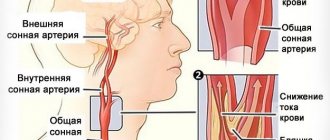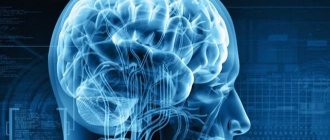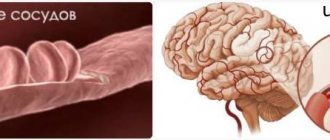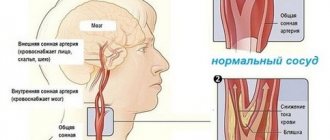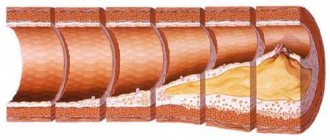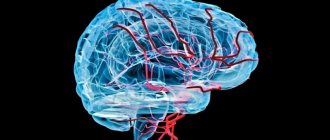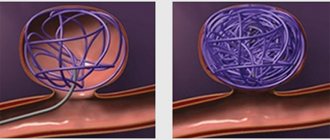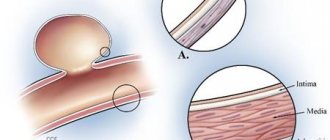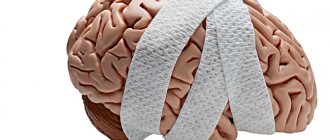REG of cerebral vessels is one of the most affordable studies in terms of cost, with the help of which abnormalities in brain function are detected. Despite the fact that vascular rheoencephalography is considered an outdated method, one cannot say that it is useless.
Such an examination often becomes decisive in establishing the final diagnosis. This allows us to save the lives of many patients.
The essence of rheoencephalography
REG is a method of studying cerebral circulation, based on the use of a rheograph, a special recording device. The measure is based on determining vascular tone and the level of blood supply in a certain area. Based on parameters such as:
- blood viscosity
- pulse wave velocity
- blood flow speed
- severity of vascular reaction
For all these indicators there is a certain norm, violation of which indicates the presence of pathologies.
Rheoencephalography is a non-invasive study that provides data on the presence of vascular pathologies in a patient. The painlessness and safety of the method allows it to be used for patients of any age, even infants.
Preparing the patient for diagnosis
The essence of the procedure is to pass a low-frequency current through the brain structures. And displaying information about the electrical resistance of organ tissues.
This is done using special equipment, which has several channels (from 2 to 6). Thanks to this, it is possible to obtain data on the state of several parts of the brain at once.
The duration of REG of cerebral vessels is no more than half an hour. In this case, actually obtaining information using sensors takes about 10 minutes. During this time, the specialist receives a fairly informative picture about the state and quality of blood flow in the great vessels, as well as collateral circulation.
This procedure determines the condition of the brain vessels, which, under the influence of unfavorable external factors or internal pathologies, wear out and cannot perform their functions fully.
Cost of the procedure and where to go
On average, the price of the procedure ranges from 1000-3500 rubles. But the patient himself decides where to go. But all experts recommend using the services of specialized centers where the technical equipment is better. In addition, such centers usually employ several specialists, so it is possible to get advice if decoding the data causes difficulties.
In some cases, specialists can go to the patient’s home with all the equipment. In this case, the cost increases significantly; such a service will cost approximately 10 thousand rubles.
Characteristic features of REG
REG shows deviations in diagnosis:
- Concussions;
- strokes;
- Hematoma;
- Vascular atherosclerosis;
- Cerebral ischemia;
- Thrombi;
- Vegetative-vascular dystonia;
REG results indicating atherosclerosis
- Pituitary adenomas;
- Parkinson's disease;
- Hearing impairment;
- Vertebrobasilar insufficiency.
Indications for the diagnosis of REG of cerebral vessels
A diagnostic measure is indicated in cases where the patient has the following complaints:
- Increased weather sensitivity;
- Frequent migraines;
- Insomnia;
- Fainting conditions;
- Deterioration or loss of memory;
- Noise in ears;
- Loss of orientation due to a sudden change in body position.
Familiarize yourself with the features of the manifestation of ischemic - /mozg/ishemicheskij-insult.html and hemorrhagic stroke - /mozg/gemorragicheskij-insult.html.
The procedure is recommended for persons whose close relatives have been diagnosed with cerebrovascular diseases.
REG of the brain may also be prescribed as an additional study after MRI.
Carrying out rheoencephalography in children is more preferable than a tomography procedure: in the latter case, placement in a machine is required and the need for a long period of time in a supine position. For REG, the child must take a sitting or lying position and wait for some time, without being left alone, as is the case when placed inside the tomograph.
REG of the head is recommended for elderly people to prevent the development of vascular diseases, since with age the arteries lose their elasticity and cannot function fully.
In addition to being non-invasive, this diagnostic procedure has the advantage of having no contraindications. A relative prohibition is the neonatal period. This is due to the fact that at this age the amplitude of the waves is small, and this significantly reduces the effectiveness of the study.
Also, REG is not performed if the skin on which the device’s electrodes need to be applied is damaged by mechanical action, as well as in case of bacterial, fungal or parasitic diseases that have spread to these areas.
When is the study scheduled?
REG and its interpretation may be required in the following conditions:
- Changes in cerebral vessels.
- Assessing the compensatory capabilities of bypass blood flow.
- Assessing the sufficiency of venous outflow, determining the degree of hypertensive syndrome.
- Dizziness.
- Diagnosis of headaches.
- Presence of noise in the head.
- For injuries of the cervical spine and head.
- Deterioration of memory, vision, hearing.
- Hypertension.
- Vascular crises.
- Meteosensitivity and vegetative-vascular dystonia.
Referral for research
Many specialists use this study and recommend it to their patients as it is more accessible than, for example, magnetic resonance imaging. Although rheoencephalography cannot be compared with MRI in terms of information content, sometimes this study is enough to make a diagnosis.
The results of rheoencephalography of cerebral vessels may be required by neurologists, vascular and neurosurgeons, as well as general practitioners.
Carrying out rheoencephalography
No special preparation is required for this diagnostic event: it is enough to spend about 30 minutes before it in a calm state, and a few hours before starting to quit smoking. In addition, you should temporarily stop taking medications that affect vascular tone.
- When examining REG, the patient is required to remain calm. To do this, it is recommended to close your eyes so that external stimuli do not affect the final result.
- The patient is asked to take a position that is comfortable for him - he can lie down or sit down.
- After this, the doctor degreases the skin with alcohol.
- covers the electrodes of the device with a gel that acts as a conductor
- imposes and secures them on certain points of the head. Depending on which areas of the brain need to be examined.
So, if a specialist evaluates the characteristics of the internal carotid artery, then the electrodes are attached to the bridge of the nose.
If the objects of study are the vertebral arteries - in the area of the mastoid process and occipital protuberances.
What examination should be done for headaches? Read the detailed article.
Equipment for conducting REG of cerebral vessels
During the procedure, a weak current is passed through the electrodes. During the process, the specialist may ask the subject to make head movements. With your neck tilted, inhale deeply and hold your breath.
This represents a functional test, which is necessary in order to compare data obtained in a state of rest and activity, to distinguish between functional and organic changes. To determine the development of collateral circulation, the carotid or vertebral arteries are clamped alternately.
As a test, the patient may be asked to take half or a whole tablet of nitroglycerin.
But only if he has:
- there is no individual sensitivity to this drug
- glaucoma
- and also if blood pressure is not reduced
During REG, readings of the resistance of brain tissue are recorded.
Thus, the specialist receives information:
- about the state of vascular tone
- elasticity of artery walls
- vascular reactivity under the influence of factors that change blood circulation
- as well as the intensity of cerebral blood supply
Normal diagnostic indications for different age groups
Rheoencephalography of cerebral vessels reflects existing venous disorders, impaired patency of the main arteries, allows one to recognize atherosclerosis and identify the degree of its severity.
Read about the treatment of cerebral atherosclerosis at the link - /mozg/ateroskleroz-sosudov-golovnogo-mozga-simptomy-i-lechenie.html.
Rheoencephalography for children
Separately, it is necessary to say about rheoencephalography for children. The entire process takes at least 15 minutes, in some cases it extends to 40 minutes.
All the time during this procedure, the child needs to lie or sit motionless, often with his eyes closed, so as not to be distracted by external stimuli.
Not everyone can sit through this amount of time, so doctors advise either to act educationally on the child, or not to undergo the examination at all when the child is restless.
Unfortunately, in this case the limitations are the same as during tomography. However, the main task of adults in this case is to tell the child why this is required, and to convince the baby of the need to lie down or sit quietly for a short time. The most important thing is that the persuasion does not take place in a stressful environment, since these consequences will blur the entire picture of the examination.
Advantages of the REG procedure of cerebral vessels
Diagnostic manipulation of REG, despite the fact that ultrasound, CT and MRI methods are increasingly preferred to it, has a number of advantages:
- The procedure is safe for the health and condition of the subject. Therefore, it can be carried out for preventive purposes without fear of consequences;
- Carrying out REG does not require much time;
- The research methodology involves taking separate readings about the condition of the veins and arteries. Which simplifies diagnosis at various stages of the disease
Arteries of the brain
- The cost of REG is not too high compared to other methods of studying cerebral circulation. Therefore, it is available to the category of people who need it relatively often - older people;
- The ability to examine the condition of blood vessels on a regular basis in the postoperative period;
- No specific preparation is required for the procedure.
Despite the fact that there are more modern and advanced diagnostic methods, they do not refuse to perform REG. Reviews from experts indicate that this method of research is useful not only as an independent diagnostic measure. But also as an additional method that allows you to get a complete picture reflecting the condition of the patient’s blood vessels.
How is a REG study of the vessels of the head performed?
The study is carried out using a special rheograph - recording equipment . The process is done in this way: a person sits or lies down, closes his eyes, electrodes are applied to certain areas of the head and neck and secured with special tapes. Often, the receiving part of the electrodes for better sensitivity of the equipment is treated with a special gel, which plays the role of a conductor. Preparation for the procedure lasts about 5 minutes .
A person needs to be prepared for the fact that the doctor will degrease the areas of the skin where the electrodes with alcohol, and then apply contacts that are coated with a conductive compound - this can cause some discomfort. Afterwards, during the examination, a weak current passes through the electrodes, and information about the resistance of brain tissue is recorded, which is then deciphered. The procedure itself, when performed correctly, is completely painless. But contact paste in some cases causes discomfort due to its presence, but a person does not need to worry because it is easily washed off .
The main difficulty during the examination is that the patient, under the stress caused by the procedure itself, becomes very nervous, because of this the blood vessels narrow, and the results are sometimes distorted . To prevent this from happening, the doctor explains the entire process in advance and talks to the patient during the examination.
Interpretation of results
When deciphering the REG, the specialist studies the amplitude of the waves that characterize the filling of certain areas of the brain with blood. Determining to what extent the norm indicators are violated. Also, to make a diagnosis, it is necessary to study the reaction of the REG wave to functional tests.
Decoding allows the specialist to make a conclusion, which determines the type of behavior of the vessels.
There are three types:
- Dystonic. In this case, a constant change in vascular tone is noted. Moreover, reduced pulse filling predominates. Under such conditions, venous outflow becomes difficult;
- Angiodystonic. This type has similar features to the one described above. Disturbance of vascular tone is also characteristic. What is associated with defects in the structure of the vascular wall;
- Hypertensive. In this case, persistent hypertonicity of the walls of the arteries that deliver blood to the brain structures predominates, and a disturbance in the outflow of venous blood from the brain is observed.
Analysis of REG curves: signs of decreased vascular tone, sharpening of the peaks, severity of dicrotic waves and their displacement to the base.
Determining the type of vascular behavior allows us to identify changes in the blood flow and deviations from normal indicators. Thus, REG indicators act as a guideline for determining the existing pathology.
When working on the obtained graphic data, the physician takes into account that the norm of their indicators depends on the age of the patient.
The result of the study will determine whether the patient has:
- Cholesterol formations on the walls of blood vessels. Which makes them less elastic;
- Blood clots, the danger of which lies in the likelihood of their breaking off and subsequent blockage of an important artery;
- Hemorrhages in brain tissue;
- Blood flow disorders;
- Increased intracranial pressure.
Conclusion REG allows us to identify pathologies affecting the cerebral arteries. And determine the appropriate direction of treatment as quickly as possible.
You can find out this very quickly - in just one day.
Differences between REG and other diagnostic methods
REG is often confused with such a diagnostic measure as EEG - electroencephalography (read the difference between REG and EEG here).
But there is a significant difference between these two methods:
- the first is used to analyze the state of the brain vessels and assess blood circulation in the organ
- the second is for studying the neural activity of individual brain regions
There is also the Echo Eg method - echoencephalography. It also differs from those described above and allows you to assess the state of brain structures.
EchoEg is characterized by the fact that during the procedure, the ultrasound signal wave is reflected at the boundaries of areas with different densities.
All the described activities complement each other, but do not replace.
Dr. Bitterlich tells more about the EchoEg diagnostic method:
